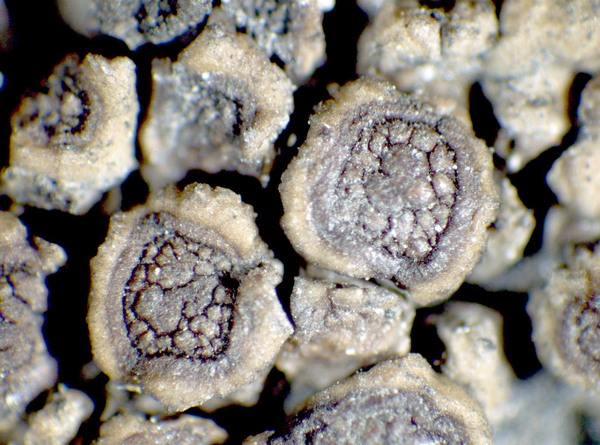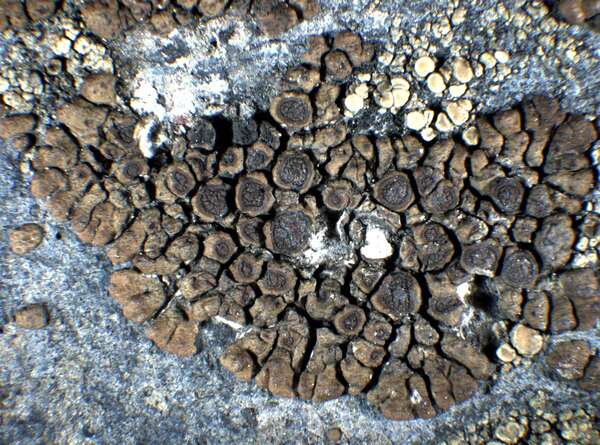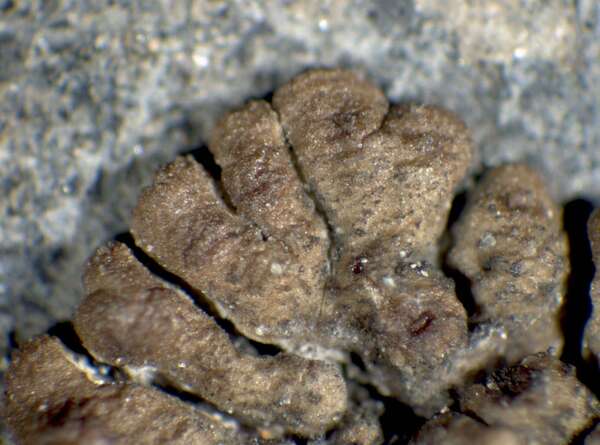Acarospora bullata Anzi
Atti Soc. Ital. Sc. Nat. Milano, 11: 165, 1868.
Synonyms:
Distribution: N - Lomb, Piem (Reeb & al. 2007), VA (HAL-18600).
Description: Thallus crustose-placodioid, episubstratic, areolate, forming 1-5 cm wide, orbicular patches; areoles round to angular, convex, 0.4-2.5 mm wide, up to 1 mm thick, contiguous or dispersed, epruinose, pale brown to olive-brown, matt, the marginal ones most often elongate and radiating, 1-2.5 mm long and 0.4-1.2 mm wide, the tips usually fan-shaped. Cortex paraplectenchymatous, 45-60 µm thick, reddish brown in upper part, colourless in lower part, overlain by a thin epicortex; algal layer continuous, 70-120 μm thick; medulla white, up to 600 μm thick, prosoplectenchymatous, the hyphae 3-4 μm wide. Apothecia aspicilioid to lecanorine, 1(-3) per areole, round to irregular in outline, 0.3-1.5 mm across, at first punctiform and immersed in the areoles, then with an expanded, dark reddish brown, epruinose or faintly pruinose, gyrose to umbilicate disc, and a rather thick, persistent thalline margin; proper margin often visible as a ring between disc and thalline margin. Proper exciple c. 20-30 µm thick; epithecium reddish brown, c. 15 μm high; hymenium colourless, 80-140(-160) µm high, the hymenial gel K/I+ dark blue or red; paraphyses 1-1.5 µm thick at mid-level, the apical cells only slightly wider; hypothecium colourless. Asci >200-spored, clavate, the apical dome K/I-, Ascospores 1-celled, hyaline, narrowly ellipsoid, 3-5 x 1.5-2 µm. Photobiont chlorococcoid. Spot tests: cortex K-, C- or C+ pink, KC+ pink, P- (reactions often ephemeral, to be observed under the microscope on thallus sections). Chemistry: cortex with gyrophoric acid. Note: on steeply inclined faces of base-rich, weakly calciferous siliceous rocks in upland areas. Probably more widespread in the Alps. Closely related to the A. peliscypha complex (Knudsen & al. 2010), this species is worthy of further study.
Growth form: Crustose
Substrata: rocks
Photobiont: green algae other than Trentepohlia
Reproductive strategy: mainly sexual
Subcontinental: restricted to areas with a dry-subcontinental climate (e.g. dry Alpine valleys, parts of Mediterranean Italy)
Commonnes-rarity: (info)
Alpine belt: rare
Subalpine belt: very rare
Oromediterranean belt: absent
Montane belt: extremely rare
Submediterranean belt: absent
Padanian area: absent
Humid submediterranean belt: absent
Humid mediterranean belt: absent
Dry mediterranean belt: absent

Predictive model
Growth form: Crustose
Substrata: rocks
Photobiont: green algae other than Trentepohlia
Reproductive strategy: mainly sexual
Subcontinental: restricted to areas with a dry-subcontinental climate (e.g. dry Alpine valleys, parts of Mediterranean Italy)
Commonnes-rarity: (info)
Alpine belt: rare
Subalpine belt: very rare
Oromediterranean belt: absent
Montane belt: extremely rare
Submediterranean belt: absent
Padanian area: absent
Humid submediterranean belt: absent
Humid mediterranean belt: absent
Dry mediterranean belt: absent

Predictive model
 Index Fungorum
Index Fungorum
 GBIF
GBIF





